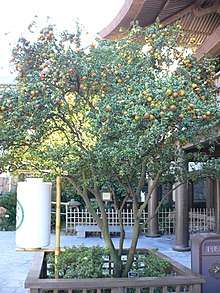Daidai
The daidai (Japanese: 橙, 臭橙; Chinese: 酸橙; Korean: 광귤, gwanggyul), is an Asian variety of bitter orange.
| Daidai | |
|---|---|
 | |
| Scientific classification | |
| Kingdom: | |
| (unranked): | |
| (unranked): | |
| (unranked): | |
| Order: | |
| Family: | |
| Genus: | |
| Species: | C. ×daidai |
| Binomial name | |
| Citrus ×daidai | |
The daidai originated in the Himalayas. It spread to the Yangtze valley region and later to Japan. The colour of the fruit loses yellowish hue and becomes greener in the spring. The native Japanese word for the color orange, (だいだい色) or daidai-iro, is derived from the name of this fruit.
Uses
There are two main cultivars, kabosu (臭橙) and kaiseitō (回青橙), and the latter bears smaller fruits than the former in Japan.[1] The fruit is very bitter, and not usually eaten, but its dried peel is used in Kampo (the Japanese adaptation of Chinese medicine); when you dry peels of young fruits, it is called kijitsu (枳実), applied as stomachic and expectorant[2] as well as laxative.[1] Peel of ripen daidai is called tohi (橙皮) use as fragrant stomachic and expectorant.[1]
The juice of the daidai can be used as an ingredient in making ponzu while kabosu is appreciated to be more fragrant.
Cultural aspect
The name daidai, originally meaning "several generations" (and written as (代代) or (代々)), came from the fruit staying on the tree for several years if not picked;[3] thus, a tree bears fruits of more than one season or from multiple years.[1] Another background of its name refers to the shape of kaiseito's calyx, which appears to be stepped or as if the fruit is borne on two pedestals or daidai (台々).[1] That is why people also called it za-daiidai (座橙々, 'daidai on pedestal')).[1]
Daidai is used as a decoration in Japanese New Year celebrations as a symbol of the family to continue for generations, and people place a fruit on top of kagami mochi, a stack of two to three round and flat mochi. This use is believed to date from the Edo period.[4]
It has not yet been resolved as a true species by The Plant List.[5]
References
- 佐藤治雄 (15 February 2005). "ダイダイ Citrus aurantium". 大阪百樹 [Osaka Hyakuju]. Archived from the original on 25 August 2007. Retrieved 2017-10-02.
- Dolf De Rovira (28 February 2008). Dictionary of Flavors. John Wiley & Sons. p. 239. ISBN 978-0-470-38484-8.
- Yoshio Hada. "ダイダイ Citrus aurantium(ミカン科ミカン属)" [Daidai C. aurantium (Citrus Rutaceae)]. Ecology and Topics of Plants (in Japanese). Okayama University of Science. Retrieved 2017-10-02.
- From a botanical essay by (菩多尼訶). Botanica (January 2005). "第二十八話 ダイダイ" [#28 Daidai]. Mampitsu Botanica [Botanica's Essays] (in Japanese). Retrieved 2 October 2017.
- "Citrus daidai Siebold ex Hayata is an unresolved name". Retrieved 18 January 2017.
| Wikimedia Commons has media related to Daidai. |